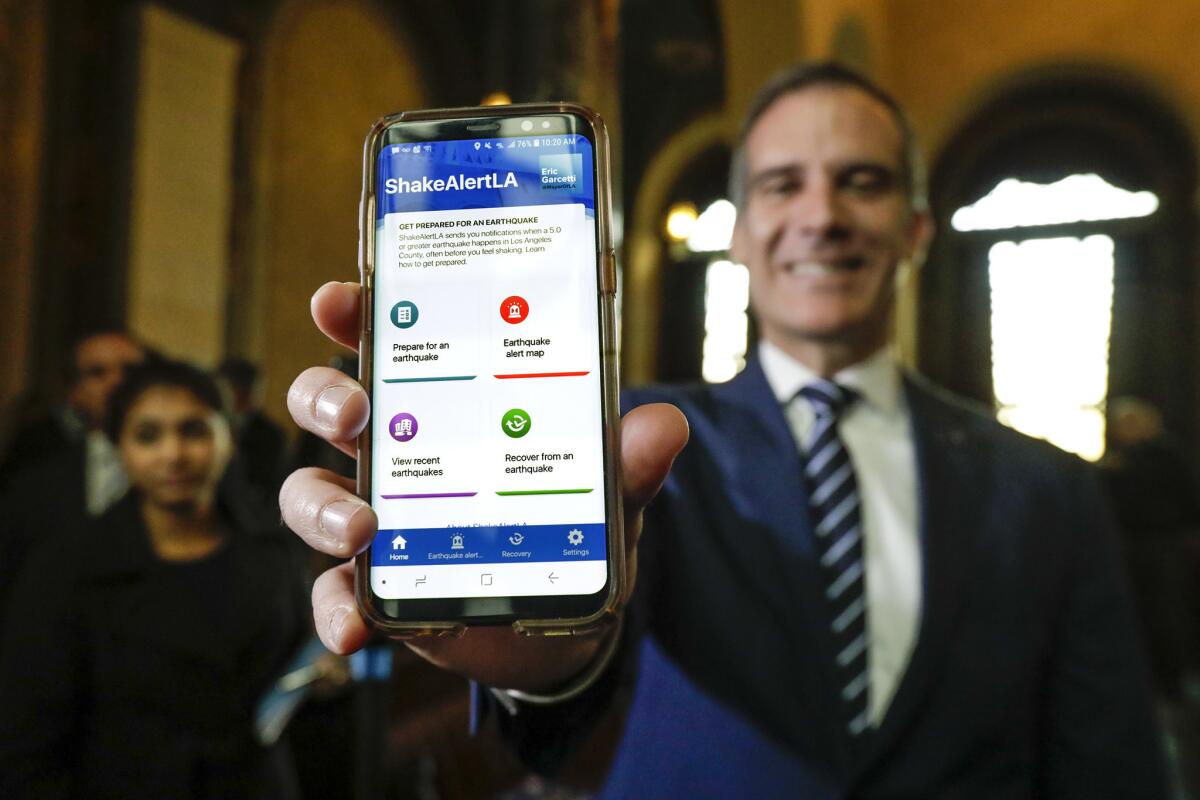L.A.’s ShakeAlert earthquake warning app worked exactly as planned. That’s the problem

- Share via
More than 500,000 people have downloaded Los Angeles County’s new ShakeAlertLA app to warn them of impending earthquakes.
So when the two strongest earthquakes in almost two decades hit Southern California this month, those residents were surprised by what they saw on their smartphones: nothing.
For the record:
3:27 p.m. July 15, 2019A previous version of this story referred to David Eisenman as the lead scientist on the Los Angeles County Community Disaster Resilience Project. He is one of the lead scientists for the project, not the only one.
Officials were quick to explain to outraged app users that the shaking in the county wasn’t strong enough to trigger an alert.
But that rationale hasn’t mollified the public.
And the program’s inauspicious start has officials grappling with an existential question that quake-prone countries such as Japan and Mexico have faced before: Is it better to issue too many earthquake warning alerts or not enough?
“We’ve long treated citizens as people who need to be protected, rather than people we need to empower,” said David Eisenman, a lead scientist on the Los Angeles County Community Disaster Resilience Project. “More information is always the way we need to go. It’s undeniable.”
Before the ShakeAlertLA app was rolled out on New Year’s Eve, researchers spent a great deal of time debating the appropriate minimum threshold for alerts, U.S. Geological Survey seismologists said. They decided to send alerts for quakes in L.A. County with a magnitude of at least 5.0, or quakes that occur anywhere and produce “light” shaking in Los Angeles.
But after the blowback that followed the Ridgecrest quakes July 4 and 5, officials agreed to lower the mark. By the end of July, the app will send alerts for local quakes with a magnitude of at least 4.5 and for any quake that results in “weak” shaking locally despite officials’ concern that too many warnings could lead to complacency.
“We want you to see the alert and immediately drop, cover and hold on,” said Robert de Groot, the USGS’ ShakeAlert national coordinator. “If you see 30 of those a day, you’re either going to get incredible muscle tone and a core workout, or you’re going to stop reacting altogether.”
Striking a balance
At 8:19 p.m. July 5, shaking was detected by several USGS seismic sensors buried in concrete vaults along the West Coast. In real time, they used cellular and radio technology to transmit data to a processing center. There, an algorithm automatically evaluated the information and determined that it fit the profile of an earthquake. An official ShakeAlert was generated — just 6.9 seconds after the first rumble.
“USGS writes the letter and puts it in the mailbox,” De Groot said. “It’s up to our partners, like the ShakeAlertLA app, to pick the letter up and deliver it.”
But the USGS had instructed the app’s developers to deliver the message to L.A. County users only if the shaking there would be strong enough to cause significant damage: shelves toppling, people being thrown around, “your favorite decorative plate from Reno flying off the wall,” De Groot said.
That amount of shaking is considered level 4 on the Modified Mercalli Intensity Scale, which is different from magnitude. The city of Ridgecrest experienced an intensity level of 8 after the 7.1 quake, causing heavy furniture to fall down and chimneys to crumble. Christmas Canyon reached an intensity level of 9, enough to shift buildings off their foundations.
But in most of L.A. County, where window blinds swayed and swimming pools sloshed, the intensity did not surpass level 3 — a degree of shaking the USGS describes as “similar to the passing of a truck.”
“Did the alert system fail people? That depends on what you consider a success,” said Caltech seismologist Lucy Jones, who specializes in science communication. “The system certainly did what it was programmed to do, so there’s the technical absolution. But then there’s the social issue — the human side of it all.”
There were plenty of humans who did not give ShakeAlertLA a passing grade.
“It failed the day I needed it most,” one critic said on Twitter. Another added: “I really expected more from this app.”
When it comes to handling the people factor, other quake-prone countries may have lessons to lend.
Japan’s Meteorological Agency established its Early Earthquake Warning system after the 1995 Kobe temblor that killed more than 6,000 people. That system includes thousands of sensors, compared with California’s approximately 800 so far, Jones said. (Japan is about the size of California but has three times as many earthquakes, she said.)
In 2011, the Early Earthquake Warning system automatically signaled high-speed trains to slow down during the 9.1 Tohoku quake that struck off Japan’s east coast, helping prevent deadly derailments. It sent alerts through the national Japanese broadcaster NHK about 90 seconds before buildings in Tokyo began to sway. Cellphone warnings that buzzed in Sendai gave university students enough time to shelter under their desks during a lecture, said Richard Allen, director of the Berkeley Seismological Laboratory.
After public awareness campaigns explained the workings of the early warning system, more than three-quarters of the Japanese public understood that false alarms were a possibility, according to a study in Earthquake Spectra, a journal published by the Earthquake Engineering Research Institute.
An erroneous alert of a magnitude 9 earthquake was sent in 2016, according to local media. Two years later, two minor temblors were mistakenly interpreted to be a single, larger earthquake that triggered a warning of strong shaking that never came.
Still, 90% of citizens surveyed said they approve of the Japanese early warning system. About 75% of people who had been sleeping before a strong earthquake said they were woken by the alert, not the shaking, and the vast majority said the alert prompted them to take protective action.
ShakeAlertLA could produce similar results, Jones said.
“The instruments in the ground and the algorithms are essentially the same in both countries,” she said. The difference lies in “how we distribute that knowledge.”
In Japan, earthquakes are discussed not on the basis of their magnitude but according to their seismic intensity in a particular location, giving residents an idea of the shaking they should expect wherever they are.
In addition, the Yurekuru smartphone app allows residents to decide for themselves how bad the shaking has to be for them to receive an alert. (Complaints from some Los Angeles residents suggest this would be a welcome feature for ShakeAlertLA.)
Mexico developed its early warning system after the 1985 Mexico City quake that killed more than 9,000. That system feeds into SkyAlert, a smartphone app designed by a private company that alerts users to any quake in the country with a magnitude of at least 4.5. Premium users, who pay about $5 a year, receive notifications when the shaking intensity at their location is expected to reach level 3, according to Alejandro Cantu, the company’s founder.
Yurekuru and SkyAlert have each been downloaded millions of times.
Weeks before a magnitude 7.1 earthquake struck central Mexico in 2017, a technician erroneously sent an alert through the capital’s 12,000 sirens. Still, researchers discovered that residents preferred the false alarm to having no warning before minor shaking arrived.
“People are remarkably tolerant of false alerts. When they got messages, they simply perceived it as the system working,” said Allen, who traveled to Mexico to evaluate public opinion immediately following the temblor.
A report on the system by Allen and his colleagues put it this way: “There seems to be general acceptance of the technical limitations of the early warning system in exchange for some measure of peace of mind.”
A live test
In L.A. County, seismologists believe one way to address concerns of an oversensitive system is to find creative ways to convey warnings, such as tailoring the messaging on the alert for varying degrees of intensity.
For example, a nuanced alert that had read, “Be aware, weak shaking is expected,” before the July 5 rolling would have been more appropriate than a universal message that read, “Drop, cover, and hold on,” Jones said.
Though many users felt let down by the ShakeAlertLA app, De Groot urged Southern Californians to keep it on their phones. The Ridgecrest quakes were beneficial in that they allowed officials to test the program in a live setting, rather than an orchestrated scenario. That’s how real problems are identified and solved — and how public trust will be rebuilt.
“I’ve seen some really interesting comments on Twitter, and hundreds of emails, which has been a joy,” De Groot said, with just a hint of sarcasm. “But the truth is, we don’t get opportunities like this very often, to learn where people’s heads are, gauge public opinion, and rethink how it all plays out.”
Times staff writers Rong-Gong Lin II and Dakota Smith contributed to this report.







